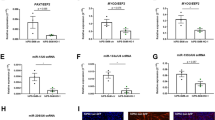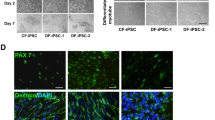Abstract
Myoblast transplantation (MT) is a cell-based gene therapy treatment, representing a potential treatment for Duchenne muscular dystrophy (DMD), cardiac failure and muscle trauma. The rapid and massive death of transplanted cells after MT is considered as a major hurdle which limits the efficacy of MT treatment. Heat shock proteins (HSPs) are overexpressed when cells undergo various insults. HSPs have been described to protect cells in vivo and in vitro against diverse insults. The aim of our study is to investigate whether HSP overexpression could increase myoblast survival after autotransplantation in pig intact skeletal muscle. HSP expression was induced by warming the cells at 42°C for 1 h. HSP70 expression was quantified by Western blot and flow cytometry 24 h after the treatment. To investigate the myogenic characteristics of myoblasts, desmin and CD56 were analysed by Western blot and flow cytometry; and the fusion index was measured. We also quantified cell survival after autologous transplantation in pig intact skeletal muscle and followed cell integration. Results showed that heat shock treatment of myoblasts induced a significative overexpression of the HSP70 (P < 0.01) without loss of their myogenic characteristics as assessed by FACS and fusion index. In vivo (n=7), the myoblast survival rate was not significantly different at 24 h between heat shock treated and nontreated cells (67.69% ± 8.35% versus 58.79% ± 8.35%, P > 0.05). However, the myoblast survival rate in the heat shocked cells increased by twofold at 48 h (53.32% ± 8.22% versus 28.27% ± 6.32%, P < 0.01) and more than threefold at 120 h (26.33% ± 5.54% versus 8.79% ± 2.51%, P < 0.01). Histological analysis showed the presence of non-heat shocked and heat shocked donor myoblasts fused with host myoblasts. These results suggested that heat shock pretreatment increased the HSP70 expression in porcine myoblasts, and improved the survival rate after autologous transplantation. Therefore, heat shock pretreatment of myoblast in vitro is a simple and effective way to enhance cell survival after transplantation in pig. It might represent a potential method to overcome the limitations of MT treatment.
Similar content being viewed by others
References
Skuk D, Tremblay J P. Cell therapies for inherited myopathies. Curr Opin Rheumatol, 2003, 15(6): 723–729
Sammels L M, Bosio E, Fragall C T, et al. Innate inflammatory cells are not responsible for early death of donor myoblasts after myoblast transfer therapy. Transplantation, 2004, 77(12): 1790–1797
Thompson R B, Emani S M, Davis B H, et al. Comparison of intracardiac cell transplantation: Autologous skeletal myoblasts versus bone marrow cells. Circulation, 2003, 108(suppl 1): II264–II271
Yoo K J, Li R K, Weisel R D, et al. Heart cell transplantation improves heart function in dilated cardio-myopathic hamsters. Circulation, 2000, 102(Suppl 3): III204–III209
Boubaker el Andalousi R, Daussin P A, Micallef J P, et al. Changes in mass and performance in rabbit muscles after muscle damage with or without transplantation of primary satellite cells. Cell Transplant, 2002, 11(2): 169–180
Ozawa E, Noguchi S, Mizuno Y, et al. From dystrophinopathy to sarcoglycano-pathy: Evolution of a concept of muscular dystrophy. Muscle Nerve, 1998, 21(4): 421–438
Zhang M, Methot D, Poppa V, et al. Cardiomyocyte grafting for cardiac repair: Graft cell death and anti-death strategies. J Mol Cell Cardiol, 2001, 33(5): 907–921
Smythe G M, Hodgetts S I, Grounds M D. Immunobiology and the future of myoblast transfer therapy. Mol Ther, 2000, 1(4): 304–313
Suzuki K, Smolenski R T, Jayakumar J, et al. Heat shock treatment enhances graft cell survival in skeletal myoblast transplantation to the heart. Circulation, 2000, 102(19 Suppl 3): III216–III221
Otterbein L E, Choi A M. Heme oxygenase: Colors of defense against cellular stress. Am J Physiol Lung Cell Mol Physiol, 2000, 279(6): L1029–L1037
Baroffio A, Aubry J P, Kaelin A, et al. Purification of humaan muscle satellite cells by flow cytometry. Muscle Nerve, 1993, 16(5): 498–505
Holzer N, Hogendoom S, Zurcher, L, et al. Autologous transplantation of porcine myogenic precursor cells in skeletal muscle. Neuromuscular Disord, 2005, 15(3): 237–244
Bouchentouf M, Benabdallah B F, Tremblay J P. Myoblast survival enhancement and transplantation success improvement by heat shock treatment in mdx mice. Transplantation, 2004, 77(9): 1349–1356
Fink A L. Chaperone-mediated protein folding. Physiol Rev, 1999, 79(2): 425–449
Sharp F R, Massa S M, Swanson R A. Heat-shock protein protection. Trends Neurosci, 1999, 22(3): 97–99
Proskuryakov S Y, Konoplyannikov A G, Gabai V L. Necrosis: a specific form of programmed cell death? Exp Cell Res, 2003, 283(1): 1–16
Skuk D, Caron N J, Goulet M, et al. Resetting the problem of cell death following muscle-derived cell transplantation: detection, dynamics and mechanisms. J Neuropathol Exp Neurol, 2003, 62(9): 951–967
Beauchamp J R, Morgan J E, Pagel C N, et al. Dynamics of myoblast transplantation reveal a discrete minority of precursors with stem cell-like properties as the myogenic source. J Cell Biol, 1999, 144(6): 1113–1122
Jaattela M, Wissing D, Bauer P A, et al. Major heat shock protein hsp70 protects tumor cells from tumor necrosis factor cytotoxicity. EMBO J, 1992, 11(10): 3507–3512
Hu Y, Benedict M A, Ding L, et al. Role of cytochrome c and dATP/ATP hydrolysis in Apaf-1-mediated caspase-9 activation and apoptosis. EMBO J, 1999, 18(13): 3586–3595
Li P, Nijhawan D, Budihardjo I, et al. Cytochrome c and dATP-dependent formation of Apaf-1/caspase-9 complex initiates an apoptotic protease cascade. Cell, 1997, 91(4): 479–489
Xanthoudakis S, Nicholson D W. Heat-shock proteins as death determinants. Nat Cell Biol, 2000, 2(9): E163–E165
Saleh A, Srinivasula S M, Balkir L, et al. Negative regulation of the Apaf-1 apoptosome by Hsp70. Nat Cell Biol, 2000, 2(8): 476–483
Beere H M, Wolf B B, Cain K, et al. Heat-shock protein 70 inhibits apoptosis by preventing recruitment of procaspase-9 to the Apaf-1 apoptosome. Nat Cell Biol, 2000, 2(8): 469–475
Park H S, Lee J S, Huh S H, et al. Hsp72 functions as a natural inhibitory protein of c-Jun N-terminal kinase. EMBO J, 2001, 20(3): 446–456
Bruey J M, Ducasse C, Bonniaud P, et al. Hsp27 negatively regulates cell death by interacting with cytochrome c. Nat Cell Biol, 2000, 2(9): 645–652
Yamashita N, Hoshida S, Nishida M, et al. Heat shock-induced manganese superoxide dismutase enhances the tolerance of cardiac myocytes to hypoxia-reoxygenation injury. J Mol Cell Cardiol, 1997, 29(7): 1805–1813
Author information
Authors and Affiliations
Additional information
Supported by the Swiss National Science Foundation (NRP 46 no. 4046-058639)
Rights and permissions
About this article
Cite this article
Yang, S., Laumonier, T. & Menetrey, J. Heat shock pretreatment enhances porcine myoblasts survival after autotransplantation in intact skeletal muscle. SCI CHINA SER C 50, 438–446 (2007). https://doi.org/10.1007/s11427-007-0065-6
Received:
Accepted:
Issue Date:
DOI: https://doi.org/10.1007/s11427-007-0065-6




